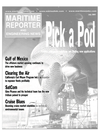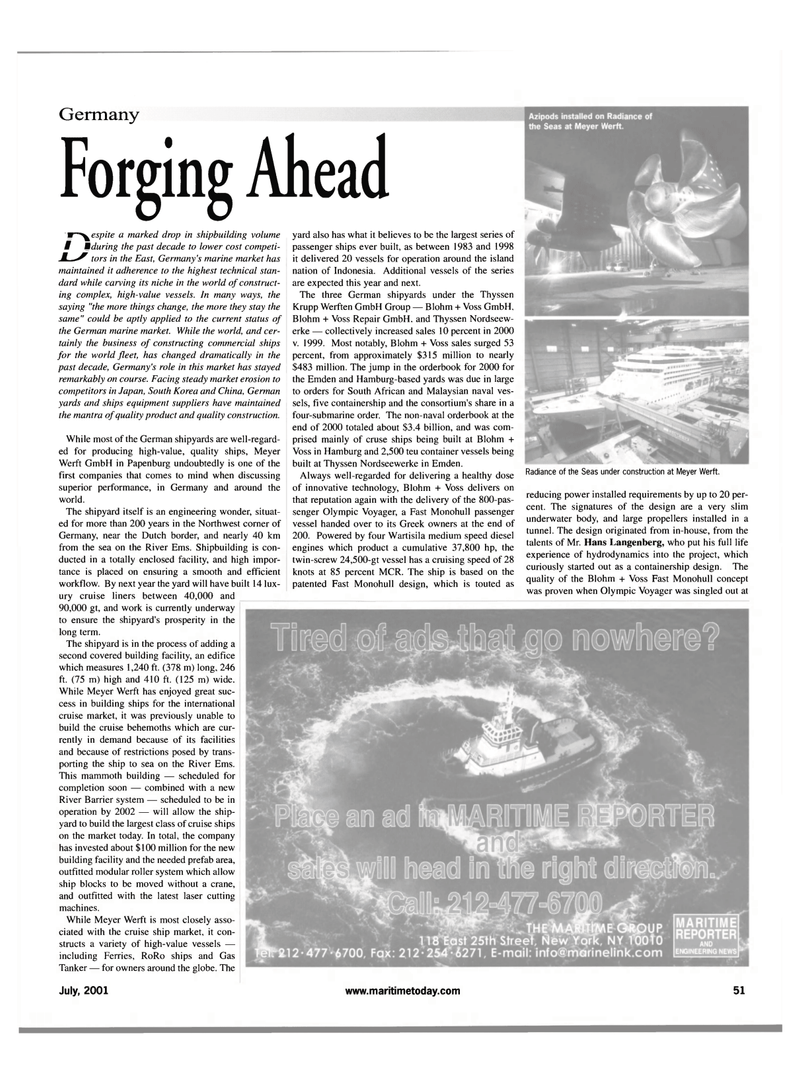
Page 59: of Maritime Reporter Magazine (July 2001)
Read this page in Pdf, Flash or Html5 edition of July 2001 Maritime Reporter Magazine
Germany Forging Ahead
W "Respite a marked drop in shipbuilding volume t Mduring the past decade to lower cost competi-
M. S tors in the East, Germany's marine market has maintained it adherence to the highest technical stan- dard while can'ing its niche in the world of construct- ing complex, high-value vessels. In many ways, the saying "the more things change, the more they stay the same" could be aptly applied to the current status of the German marine market. While the world, and cer- tainly the business of constructing commercial ships for the world fleet, has changed dramatically in the past decade, Germany's role in this market has stayed remarkably on course. Facing steady market erosion to competitors in Japan, South Korea and China, German yards and ships equipment suppliers have maintained the mantra of quality product and quality construction.
While most of the German shipyards are well-regard- ed for producing high-value, quality ships, Meyer
Werft GmbH in Papenburg undoubtedly is one of the first companies that comes to mind when discussing superior performance, in Germany and around the world.
The shipyard itself is an engineering wonder, situat- ed for more than 200 years in the Northwest corner of
Germany, near the Dutch border, and nearly 40 km from the sea on the River Ems. Shipbuilding is con- ducted in a totally enclosed facility, and high impor- tance is placed on ensuring a smooth and efficient workflow. By next year the yard will have built 14 lux- ury cruise liners between 40,000 and 90,000 gt, and work is currently underway to ensure the shipyard's prosperity in the long term.
The shipyard is in the process of adding a second covered building facility, an edifice which measures 1,240 ft. (378 m) long, 246 ft. (75 m) high and 410 ft. (125 m) wide.
While Meyer Werft has enjoyed great suc- cess in building ships for the international cruise market, it was previously unable to build the cruise behemoths which are cur- rently in demand because of its facilities and because of restrictions posed by trans- porting the ship to sea on the River Ems.
This mammoth building — scheduled for completion soon — combined with a new
River Barrier system — scheduled to be in operation by 2002 — will allow the ship- yard to build the largest class of cruise ships on the market today. In total, the company has invested about $100 million for the new building facility and the needed prefab area, outfitted modular roller system which allow ship blocks to be moved without a crane, and outfitted with the latest laser cutting machines.
While Meyer Werft is most closely asso- ciated with the cruise ship market, it con- structs a variety of high-value vessels — including Ferries, RoRo ships and Gas
Tanker — for owners around the globe. The yard also has what it believes to be the largest series of passenger ships ever built, as between 1983 and 1998 it delivered 20 vessels for operation around the island nation of Indonesia. Additional vessels of the series are expected this year and next.
The three German shipyards under the Thyssen
Krupp Werften GmbH Group — Blohm + Voss GmbH,
Blohm + Voss Repair GmbH, and Thyssen Nordseew- erke — collectively increased sales 10 percent in 2000 v. 1999. Most notably, Blohm + Voss sales surged 53 percent, from approximately $315 million to nearly $483 million. The jump in the orderbook for 2000 for the Emden and Hamburg-based yards was due in large to orders for South African and Malaysian naval ves- sels, five containership and the consortium's share in a four-submarine order. The non-naval orderbook at the end of 2000 totaled about $3.4 billion, and was com- prised mainly of cruse ships being built at Blohm +
Voss in Hamburg and 2,500 teu container vessels being built at Thyssen Nordseewerke in Emden.
Always well-regarded for delivering a healthy dose of innovative technology, Blohm + Voss delivers on that reputation again with the delivery of the 800-pas- senger Olympic Voyager, a Fast Monohull passenger vessel handed over to its Greek owners at the end of 200. Powered by four Wartisila medium speed diesel engines which product a cumulative 37,800 hp, the twin-screw 24,500-gt vessel has a cruising speed of 28 knots at 85 percent MCR. The ship is based on the patented Fast Monohull design, which is touted as
Radiance of the Seas under construction at Meyer Werft. reducing power installed requirements by up to 20 per- cent. The signatures of the design are a very slim underwater body, and large propellers installed in a tunnel. The design originated from in-house, from the talents of Mr. Hans Langenberg, who put his full life experience of hydrodynamics into the project, which curiously started out as a containership design. The quality of the Blohm + Voss Fast Monohull concept was proven when Olympic Voyager was singled out at
July, 2001 www.maritimetoday.com 51

 58
58

 60
60
